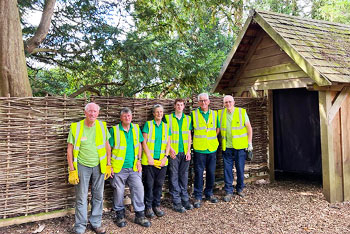Restoring Westonbirt's bird hide
In the early part of 2021, the nine Estate Volunteers took the decision to take part in a John Muir Award scheme with full support from Westonbirt Arboretum. The project chosen was to update and renovate a well-loved and used bird hide situated in the Old Arboretum. Work would basically involve removing the old fencing due to its poor condition and replacing it with new hazel panels, also updating the hide itself and the surrounding area.
Who was John Muir?
John Muir was born in 1838 in Dunbar, Scotland, where he had a sense of adventure and a love for the natural world. In his early years, the family emigrated to Wisconsin, USA. It is here where he found his love for botany and geology. The following years saw him travel extensively across America spending six years in Yosemite Valley studying wildlife and geology.
It was in those years that John Muir developed a National Parks philosophy, to cut a long story short, through John Muir the Yosemite Valley became a National Park in 1864. From here on he was regarded as the founder of the National Park movement worldwide.
The John Muir Award was set up in his name by the John Muir Trust. It requires participants to cover four challenges, Discover the Wildlife, Explore It, Conserve It and Share Your Experiences. The four Challenges are there to help promote a holistic approach to outdoor experiences. They reflect the approach that John Muir took during his travels and adventures. For us, the Estate Volunteers, we decided to take on Westonbirt Arboretum’s bird hide and feeding area as it needed some loving care and attention.
The Bird Hide
The bird hide is situated in the Old Arboretum, it is a large oak framed wooden clad building approximately 25 ft X 10 ft. The fencing either side of the hide is made of woven hazel panels. Along the back facing the hide are various trees and shrubs also an old stone wall forming a boundary onto a field. The birds are fed from feeders suspended from a wire across the feeding area, also from holes in a dead tree trunk along with water in a bird bath. Inside the hide is a bird identification chart and two benches for visitors to sit on. The floor inside is covered with wood chip and at either end of the hide are entrances covered with black material. The hide is well visited by the public, both young and old alike.
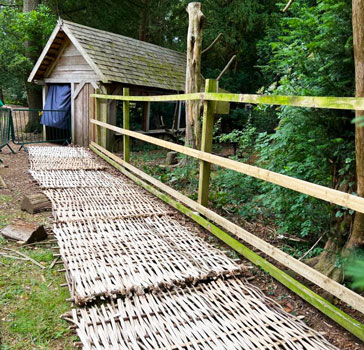
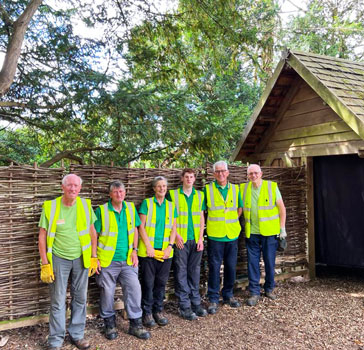
The Four Challenges
Discover the Wildlife
Within the feeding area various species of wildlife have been observed from Greater Spotted Wood Peckers, Sparrows, Tree Creepers, Nut Hatches Blue & Great Tits, Black Caps, Pigeons, Pheasants, also Grey Squirrels, Badgers, Mice. Visiting birds and animals initially come into the hedgerow before briefly visiting the feeders, or the ground beneath the feeders. Various birds are quite particular in what they eat, after taking a seed if the bird doesn’t like it will discard it, usually ending up the floor where other birds and animals will eat it. Each feeder contains a different food source from peanuts, fat balls, mixed seed and sun flower seeds.
Explore It
Access to the bird hide is only available during the opening hours for the Arboretum. It can be found on the edge of the Old Arboretum not far from the Tree Management Centre. The feeders are suspended from a wire that runs across the feeding area and are checked and filled up every other day by either full time staff or volunteers. Water is also supplied and topped up at the same time as the feeders. In the hide is a bird identification chart for those birds most commonly seen in and around the arboretum.
The bird hide is made from oak with a shingle roof, the fencing panels either side of the hide are made of split woven hazel. Like all timber it has a finite life. The hide itself is approximately 15 years old and in good condition but requires a clean. The wood chip flooring wants replacing as its turning to dust. Also the entrance curtains have seen better days and require replacing. The fence panels either side of the feeding area have become very brittle and are deteriorating to the extent they are falling apart and ready for replacement.
Conserving it
At the beginning of 2022 we teamed up with Brian Williamson the Coppice Manager to teach us the art of making split hazel fencing panels. As no one had done this form of woven fencing before it was going to be a steep learning curve. Our first task was to learn how to split hazel rods down the centre that Brian had coppiced on site. This required the use of a very sharp bill hook, a form of axe. This is a difficult technique that takes years of experience to perfect, so Brian very kindly offered to split them for us to avoid wastage and help us focus on weaving the panels”.
As for weaving the panels, Brian started off teaching us the technique, preparing the uprights called sails. These were placed upright into holes equally spaced around a slight curve in a plank of wood. This was followed by weaving the split hazel, twisting in the bottom rows in a certain way ensuring the split face stayed on one side. The subsequent weaving again proved to be a steep learning curve for us. The most difficult part was twisting the split rods around the two end sails without breaking the rods. Having woven up to a certain height using a marker pole came the difficult part of locking in the top weave. This is finished off using a hazel rod, not split, and having a double twist on one of the end sails and finally locking it off.
Initially, when we started weaving our first panel with Brian guiding us it took us about 5 hrs to weave only halve a panel. With experience after about ten panels woven, we managed to make 2 panels a day, finishing off on the last day making 3 complete panels.
It was a great experience making panels and learning an ancient skill. We also learnt that to get the best results and to make it easier to weave the hazel had to be freshly coppiced, split and then woven. If allowed to dry out before splitting and weaving the hazel then became very difficult to use and it tended to break, which you don’t want. A total of 12 panels were made over a 2½ month period.
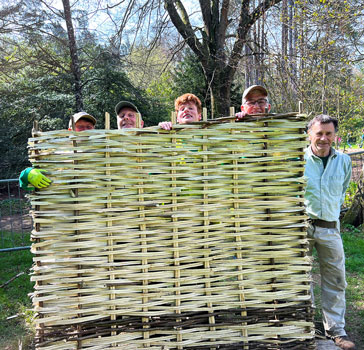
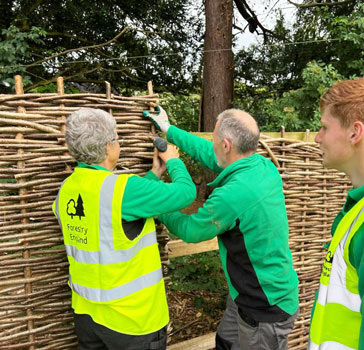
The bird hide itself required cleaning and the wood chip flooring replacing, also the two entrance curtains replacing. Removing the old wood chip floor down to the soil floor was a very dusty task, dust masks had to be worn during the process. The inside walls and roof of the hide were swept clean and finally new wood chip flooring was laid. The old black curtains at both entrances were replaced with new dark green heavy-duty material more in keeping with the surrounding environment. As for the exterior walls of the bird hide these were given a light brush, not to remove the patina but just to look cleaner.
The feeding area was cleaned up removing old plastic netting and other materials that did not give that natural woodland look from the hide. Two new feeding stations were fitted to dead branches in the form of flat bird tables. These were made from slicing through cut logs giving that natural look.
Various types of feeding stations containing fat balls, peanuts and a mixture of seeds were hung from a wire across the feeding area. On the ground is a bird bath for birds to drink from, and a fallen tree trunk, also used as a natural feeding station, besides other pieces of wood and branches.
As a volunteer group meeting only once a week on a Wednesday it would prove difficult in maintaining the feeding stations. With interest shown by two other groups, they have volunteered to check on the feeders on a Monday and Friday.
In months and years to come the Estates Volunteers will carry out ongoing work/renovation as and when necessary.
Sharing our Experiences
As Westonbirt is open to the public, all our tasks during this project were carried out with the public seeing the work and actively showing an interest asking questions. It was a real privilege to explain to the public what we were doing now and in the long term, receiving very good comments and appreciation.
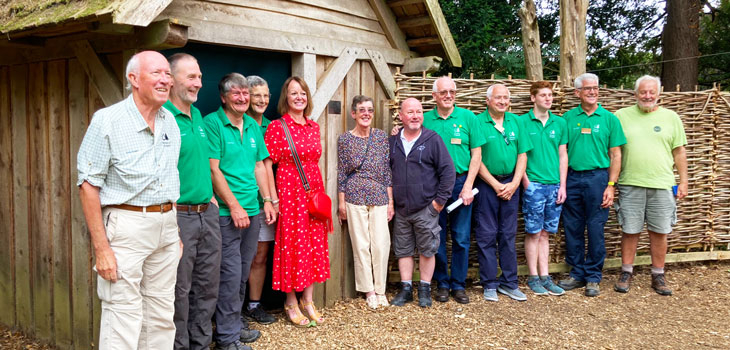
In a couple of instances people had not realised there was a bird hide on site and were most interested in locating it and wanting to see the project when completed. During the making of the hazel panels the public were very interested asking many questions in the process and were pleased we were using materials from the site where at all possible.
Our experience of the whole process of renovating the site was shared with other volunteers and staff members with a presentation and site visit.
